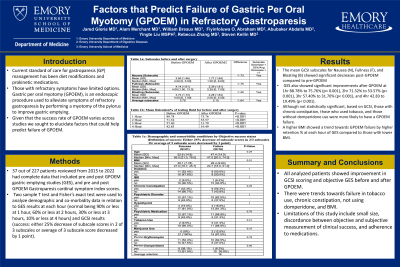Tuesday Poster Session
Category: Interventional Endoscopy
P4458 - Factors That Predict Failure of Gastric Per Oral Myotomy (GPOEM) in Refractory Gastroparesis
Tuesday, October 29, 2024
10:30 AM - 4:00 PM ET
Location: Exhibit Hall E

Has Audio

Alam Merchant, MD
Emory University School of Medicine
Atlanta, GA
Presenting Author(s)
Jared Gloria, MD1, Alam Merchant, MD2, William Breaux, MD2, Fiyinfoluwa O. Abraham, MD2, Abubaker Abdalla, MD2, Yingte Liu, MSPH3, Rebecca Zhang, MS4, Steven Keilin, MD2
1Emory University School of Medicine, Decatur, GA; 2Emory University School of Medicine, Atlanta, GA; 3Emory University, Atlanta, GA; 4RSPH, Atlanta, GA
Introduction: Gastroparesis (GP) is delayed gastric emptying in the absence of mechanical obstruction that causes symptoms of early satiety, bloating, abdominal pain, and vomiting. GP has been treated by diet modifications and prokinetic medications. Those with refractory symptoms have limited options and treatments used historically lack evidence. Gastric per oral myotomy (GPOEM), is an endoscopic procedure used to alleviate symptoms of refractory gastroparesis by performing a myotomy of the pylorus to improve gastric emptying. Given that the success rate of GPOEM varies across studies we sought to elucidate factors that could help predict failure of GPOEM.
Methods: 227 patients were identified as having GPOEM for GP from 2015 to 2022. Demographics, co-morbidities, pre-and post- GPOEM gastric emptying studies (GES), and pre- and post-GPOEM Gastroparesis Cardinal Symptom Index (GCSI) were collected. 37 patients had complete data and were analyzed. A mixture of two-sample T test and Fisher’s exact test were used to analyze demographic and co-morbidity data in relation to GES results at each hour (normal being 90% or less at 1 hour, 60% or less at 2 hours, 30% or less at 3 hours, 10% or less at 4 hours) and GCSI results (success: either 25% decrease of s0ubscale scores in 2 of 3 subscales or average of 3 subscale score decreased by 1 point).
Results: The mean GCSI subscales for Nausea (N), Fullness (F), and Bloating (B) showed significant decreases post-GPOEM compared to pre-GPOEM (N 3.5 to 1.77, F 4.14 to 2.39, B 3.73 to 2.28). GES also showed significant improvements after GPOEM at 1hr 88.78% to 75.76% (p< 0.001), 2hr 71.32% to 53.57% (p< 0.001), 3hr 57.40% to 31.70% (p< 0.001), and 4hr 42.83 to 19.49% (p< 0.001). Although not statistically significant, based on GCSI, those with chronic constipation, those who used tobacco, and those without domperidone use were more likely to have a GPOEM failure. Finally, a higher BMI showed a trend towards GPOEM failure by higher retention % at each hour of GES compared to those with lower BMI.
Discussion: All analyzed patients showed improvement in GCSI scoring and objective GES before and after GPOEM. There were no co-morbidities that showed significant impact on failure of GPOEM, however, there were trends towards failure in tobacco use, chronic constipation, not using domperidone, and BMI. Limitations of this study include small size, discordance between objective and subjective measurement of clinical success, and adherence to medications.
Note: The table for this abstract can be viewed in the ePoster Gallery section of the ACG 2024 ePoster Site or in The American Journal of Gastroenterology's abstract supplement issue, both of which will be available starting October 27, 2024.
Disclosures:
Jared Gloria, MD1, Alam Merchant, MD2, William Breaux, MD2, Fiyinfoluwa O. Abraham, MD2, Abubaker Abdalla, MD2, Yingte Liu, MSPH3, Rebecca Zhang, MS4, Steven Keilin, MD2. P4458 - Factors That Predict Failure of Gastric Per Oral Myotomy (GPOEM) in Refractory Gastroparesis, ACG 2024 Annual Scientific Meeting Abstracts. Philadelphia, PA: American College of Gastroenterology.
1Emory University School of Medicine, Decatur, GA; 2Emory University School of Medicine, Atlanta, GA; 3Emory University, Atlanta, GA; 4RSPH, Atlanta, GA
Introduction: Gastroparesis (GP) is delayed gastric emptying in the absence of mechanical obstruction that causes symptoms of early satiety, bloating, abdominal pain, and vomiting. GP has been treated by diet modifications and prokinetic medications. Those with refractory symptoms have limited options and treatments used historically lack evidence. Gastric per oral myotomy (GPOEM), is an endoscopic procedure used to alleviate symptoms of refractory gastroparesis by performing a myotomy of the pylorus to improve gastric emptying. Given that the success rate of GPOEM varies across studies we sought to elucidate factors that could help predict failure of GPOEM.
Methods: 227 patients were identified as having GPOEM for GP from 2015 to 2022. Demographics, co-morbidities, pre-and post- GPOEM gastric emptying studies (GES), and pre- and post-GPOEM Gastroparesis Cardinal Symptom Index (GCSI) were collected. 37 patients had complete data and were analyzed. A mixture of two-sample T test and Fisher’s exact test were used to analyze demographic and co-morbidity data in relation to GES results at each hour (normal being 90% or less at 1 hour, 60% or less at 2 hours, 30% or less at 3 hours, 10% or less at 4 hours) and GCSI results (success: either 25% decrease of s0ubscale scores in 2 of 3 subscales or average of 3 subscale score decreased by 1 point).
Results: The mean GCSI subscales for Nausea (N), Fullness (F), and Bloating (B) showed significant decreases post-GPOEM compared to pre-GPOEM (N 3.5 to 1.77, F 4.14 to 2.39, B 3.73 to 2.28). GES also showed significant improvements after GPOEM at 1hr 88.78% to 75.76% (p< 0.001), 2hr 71.32% to 53.57% (p< 0.001), 3hr 57.40% to 31.70% (p< 0.001), and 4hr 42.83 to 19.49% (p< 0.001). Although not statistically significant, based on GCSI, those with chronic constipation, those who used tobacco, and those without domperidone use were more likely to have a GPOEM failure. Finally, a higher BMI showed a trend towards GPOEM failure by higher retention % at each hour of GES compared to those with lower BMI.
Discussion: All analyzed patients showed improvement in GCSI scoring and objective GES before and after GPOEM. There were no co-morbidities that showed significant impact on failure of GPOEM, however, there were trends towards failure in tobacco use, chronic constipation, not using domperidone, and BMI. Limitations of this study include small size, discordance between objective and subjective measurement of clinical success, and adherence to medications.
Note: The table for this abstract can be viewed in the ePoster Gallery section of the ACG 2024 ePoster Site or in The American Journal of Gastroenterology's abstract supplement issue, both of which will be available starting October 27, 2024.
Disclosures:
Jared Gloria indicated no relevant financial relationships.
Alam Merchant indicated no relevant financial relationships.
William Breaux indicated no relevant financial relationships.
Fiyinfoluwa Abraham indicated no relevant financial relationships.
Abubaker Abdalla indicated no relevant financial relationships.
Yingte Liu indicated no relevant financial relationships.
Rebecca Zhang indicated no relevant financial relationships.
Steven Keilin indicated no relevant financial relationships.
Jared Gloria, MD1, Alam Merchant, MD2, William Breaux, MD2, Fiyinfoluwa O. Abraham, MD2, Abubaker Abdalla, MD2, Yingte Liu, MSPH3, Rebecca Zhang, MS4, Steven Keilin, MD2. P4458 - Factors That Predict Failure of Gastric Per Oral Myotomy (GPOEM) in Refractory Gastroparesis, ACG 2024 Annual Scientific Meeting Abstracts. Philadelphia, PA: American College of Gastroenterology.
